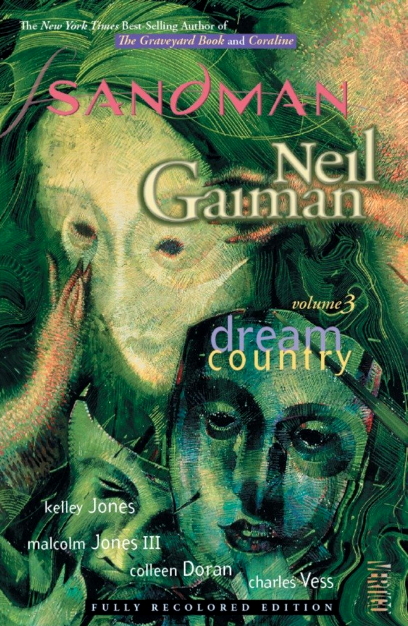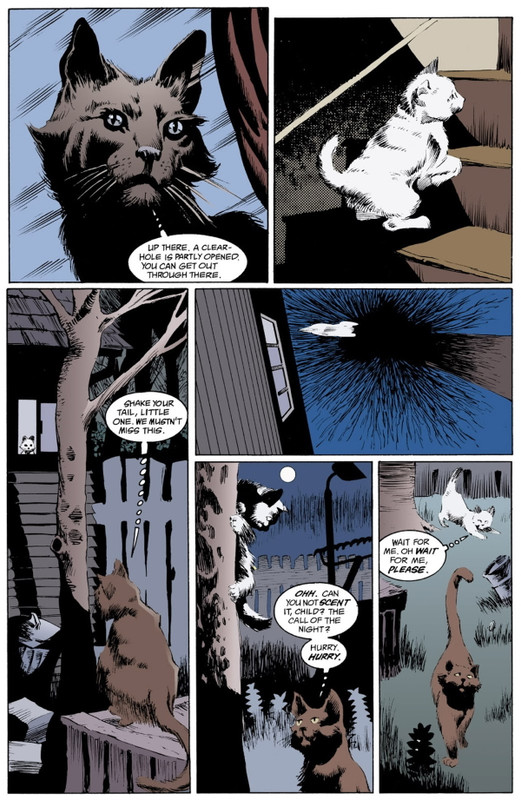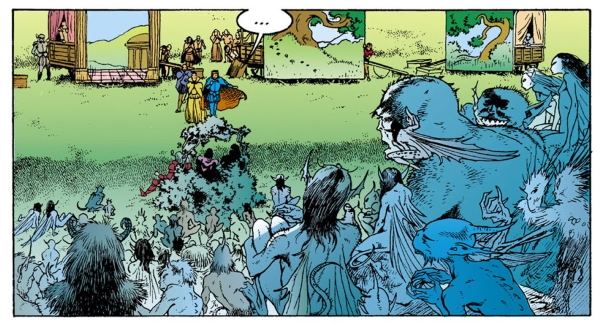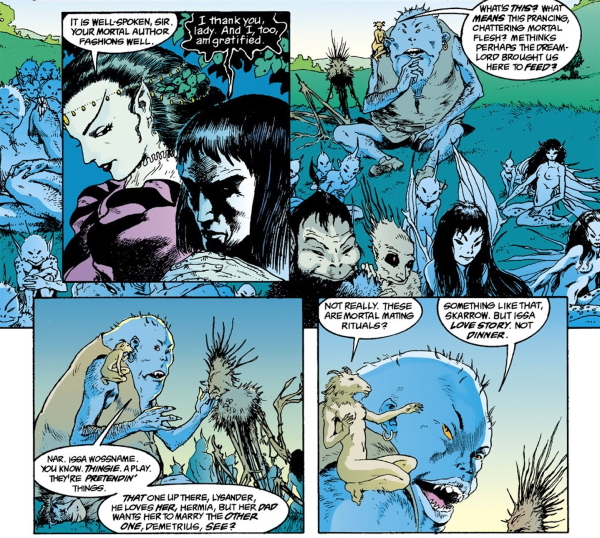The Sandman: Volume 3 – Dream CountryOriginal publication:
The Sandman #17–20 (July 1990 – October 1990)
Script: Neil Gaiman
Artwork: Kelley Jones (pencils)/Malcolm Jones III (inks)/Charles Vess (pencils & inks)/Colleen Doran (pencils)
 Publisher's synopsis
Publisher's synopsis:
The third book of the Sandman collection is a series of four short comic book stories. In each of these otherwise unrelated stories, Morpheus serves only as a minor character. Here we meet the mother of Morpheus's son, find out what cats dream about, and discover the true origin behind Shakespeare's A Midsummer's Night Dream. The latter won a World Fantasy Award for best short story, the first time a comic book was given that honor.So, my read through of
The Sandman continues with Volume 3:
Dream Country...
I felt that this was the best volume of
The Sandman so far. It's a pretty slim collection – only four issues – and is made up of unrelated, stand-alone stories. These stories may seem a little like "filler issues", but if so, they are also some of the best filler issues you're ever likely to read.
Dream, the central character of
The Sandman so far, is only peripherally involved in these tales, but that doesn't matter one jot. This is a collection of stories about stories, and, for me, it was the point where I felt that Neil Gaiman's writing chops wholly matched the breadth of his vision for the first time.
CalliopeOf the four stories in "Dream Country", I felt that "Calliope" was a particularly memorable and enjoyable moralistic tale. It centres on a struggling young author with severe writer's block named Richard Madoc. After obtaining a rare trichobezoar (a mass of hair follicles that can get trapped in the gastrointestinal system of those who suck their hair), Madoc trades it to an ill-tempered old writer named Erasmus Fry. What Madoc gets in return is his muse. Literally! He gets Calliope, one of the muses from Greek Mythology, who Fry trapped on Mount Helicon in Greece back in 1927 and has kept imprisoned at his home ever since.
Following the trade, Madoc returns to his abode, where he too imprisons Calliope and continually rapes her in order to provoke inspiration. As a result, his creative dry spell ends and he writes novel after novel, becoming a tremendously successful author, all the while continuing to subjugate and violate poor Calliope year after year...

Thankfully, this was one of the less gratuitous rapes to appear in comic books. I don't feel that it was in any way sensationalised or – even worse – presented as something abhorrent, while secretly trying to titillate male readers (which is more common in comics than you might think, I believe). This particular instance of ravishment is, I'm certain, Gaiman's metaphor for writers, artists, musicians, or any other kind of creative individual, and how they unrelentingly demand servitude from their muse. It's also a commentary on how ill-tempered, unpleasant and abusive – to others and themselves! – they can become if that inspiration isn't forthcoming. And after all, don't all artists abuse their creative gifts?
As a songwriter and musician myself, this episode of
The Sandman resonated particularly strongly with me. Just like the story's central character, I too have had moments of frustration and even panic when inspiration seemed elusive – that horrible, nagging fear that your muse may be gone forever. It's not a pleasant experience, I can tell you...especially when you have managers, A&R men, record companies etc clamouring for "product". In that respect, I could definitely sympathise with Madoc, even while I felt revulsion at his abuse of Calliope and his pathetic lust for critical renown and public glory.
As you might expect from an author like Gaiman, "Calliope" contains lots of metacommentary about the art of prose composition, the nuts & bolts of the writing process, and even the manipulative and duplicitous nature of writing. At one point Fry tells Calliope, "
Writers are liars, my dear. Surely you have realized that by now?" Yeah, and so are songwriters. And painters. And sculptors. And playwrights. And poets. Especially poets!
In the end, Morpheus intervenes and frees Calliope from her bondage, punishing Madoc in a deliciously ironic way, by cursing him with an over-abundance of creative ideas that eventually drive him insane. "Calliope" is a weird sort of story: it's equal parts gothic horror, literary thriller, and cautionary, Aesop-like fable, but I liked it a lot. It's also rather nicely drawn by Kelley Jones, whose shadowy artwork certainly adds to the tale's foreboding undercurrent of obsessive desire for glory at all costs.
A Dream of a Thousand CatsAnother stand out chapter in "Dream Country" was "A Dream of a Thousand Cats", which is a story about domestic felines, told entirely from the perspective of anthropomorphised domestic felines. Despite what you might think, this isn't a "cutesy" story...well, actually, it
is kinda cutesy, but it's not sickly cute – in fact, parts of it are heartbreaking. And it definitely still feels very much in keeping with the direction that the series is heading in recently. I don't know for sure, but I bet Gaiman is a cat person. He clearly "gets" cats, and is also somewhat romanced by their proud, rough and tumble nonchalance and their innate air of wisdom...

It would take too long to describe exactly what happens in this kitty conspiracy tale – and anyway, I wouldn't want to spoil the story for anyone else. But Suffice it to say that, if you're a cat lover, as well as the owner of cats (as I am), you will smile knowingly a lot of the time during this tale. You may well get upset too. But you will certainly never look at your precious pussy cat, as they twitch in their dreams, in quite the same way again.
A Midsummer Night's DreamFor me, the very best issue in this book was "A Midsummer Night's Dream", in which William Shakespeare performs his new play (the titular
A Midsummer Night's Dream) for the first time. This story is linked to events in Volume 2 of
The Sandman, "The Doll's House", in which Dream and Shakespeare struck a deal. As a result, the Bard has to drag his company of actors out into the rolling English countryside to premier
A Midsummer Night's Dream, his newest play, seemingly without an audience. However, when an audience does finally appear from a door in the earth – out of the Long Man of Wilmington hill figure in Sussex, no less! – it is a congregation of faerie folk, including such key characters from the play as Oberon, Titania and Puck...

OK, full disclosure time: I'm really not much of a Shakespeare fan. There, I said it! (Oops, wrong thread!) But I do love
A Midsummer Night's Dream, and I consider it by far the Bard's best work (at least among those that I have read or seen performed). So, I got a real kick out of this chapter, which, I must just say, is beautifully drawn by Charles Vess.
Gaiman's writing in this issue is thematically complex, often touching, beautifully eloquent, and just downright brilliant from start to finish. The story is kind of anchored upon Shakespeare's relationship with his son, which serves to give it some earthbound heart amid the parade of supernatural sprites and faeries. Actually, while I'm talking about the assembled faerie folk, there's some nicely humorous dialogue between two sprites in the audience, which runs throughout the issue...

"A Midsummer Night's Dream" is not just a retelling of the play: it is an episode of
The Sandman which explains how the play is actually an homage to the faerie that was commissioned by Morpheus himself, so that King Oberon and Queen Titania of the faerie, "
will be remembered by mortals, until this age is gone." In return, Dream grants Shakespeare what he thinks he most desires: everlasting fame and glory (which, it's hinted, is a double-edged sword). Interestingly, Puck – Robin Goodfellow himself – remains behind in our world, once the faerie folk depart, with the suggestion being that he's still out there somewhere, causing mischief in the present day. I suspect we might see more of Puck later on in the series.
"A Midsummer Night's Dream" really is excellent and an absolute master class of a comic.
FaçadeThe final story in this book is titled "Façade" and this was the only story in the volume that I felt was less than fantastic. It centres around Element Girl from DC's old
Metamorpho comics from the mid-60s. To be honest, I had to Google who the hell Urania Blackwell was, as I had absolutely no idea (as previously noted, I'm not the biggest DC fan in the world). This issue was unrelentingly bleak, but it was somewhat interesting insofar as Urania is thousands of years old and all she really wants to do is die. But despite having this rather interesting concept at its core, the story never really hooked me in the way that the other three did.
Overall, this was a hugely enjoyable volume of
The Sandman. It showcases a variety of different genre types, while remaining consistent with the feel and style of
The Sandman series. Although it hardly features Morpheus, for me "Dream Country" finally justified the hype that this series gets. I'm definitely hooked on
The Sandman now and can't wait to get on to volume 4, "Season of Mists"!